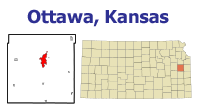Almost six years ago, we told readers about Ottawa, Kansas, where the community of around 13,000 people had invested in publicly owned fiber optic connectivity for local businesses. We recently touched base with IT Director Paul Sommer, who updated us on the progress of their broadband utility and how it has impacted the community.
Steady as it Grows
When we first met Ottawa, they had worked with the local school district and Franklin County to capitalize on existing fiber infrastructure and expand to more locations. Local leaders had learned from Ottawa businesses that the best options available from incumbent AT&T were T1 lines for approximately $600. Higher capacity connections were scarce and financially out of reach for local establishments, and AT&T could not be convinced to upgrade their infrastructure. As Bigham put it, AT&T was "milking the cow."
Once the city, school district, and Franklin County established a partnership, Ottawa began to expand fiber to other municipal facilities and businesses as requested. Sommers, who has taken over as IT Director, says that now all 10 city buildings are on the network. In addition to an industrial park on the original infrastructure on the north end of town, the network now reaches an industrial park to the south.
The electric utility has trained their own staff rather than hiring external fiber deployment personnel. In addition to enriching skills, their employees are able to respond quickly if there are downed cables or other maintenance issues. Sommers recalls an instance when a car, which had caught fire, sent shrapnel flying into the air. By a twist of fate, one piece severed the fiber optic cable hanging some distance away. His team was able to rehang and splice the cable that same day and get the subscriber back online.
By using electric utility staff, Ottawa has reduced the cost of their incremental build over the years. They typically budget around $100,000 each year for expansion of the network, have never gone over, and often don’t spend the entire allotment. Sommers says that, since they own the utility poles in town, have necessary personnel on hand, and equipment at the ready, unnecessary bureaucracy doesn’t slow down maintenance, repairs, or expansion efforts.
Bursting at the Streams
 When Ottawa began offering service to local businesses and the school district, they decided to take a different approach than the large Internet access companies and they continue that policy today. Even though subscribers may pay for a specific service tier, they are allowed to burst to whatever capacity is available on the network at the time they need it. Sommers says that most subscribers in Ottawa don’t use as much bandwidth as they think they do. They monitor bandwidth use and no one has ever abused the ability to burst.
When Ottawa began offering service to local businesses and the school district, they decided to take a different approach than the large Internet access companies and they continue that policy today. Even though subscribers may pay for a specific service tier, they are allowed to burst to whatever capacity is available on the network at the time they need it. Sommers says that most subscribers in Ottawa don’t use as much bandwidth as they think they do. They monitor bandwidth use and no one has ever abused the ability to burst.
The city utility is always looking for new ways to use their fiber optic assets for subscribers’ advantage, says Sommers. For example, when a subscriber has multiple buildings that need service, they link them to create a local area network, so communication between facilities is faster and remains internal. Most of Ottawa's local businesses subscribe to service from the city utility — more than 20 establishments of varying size.
According to Sommers, the people who handle businesses’ IT issues appreciate Ottawa’s investment the most. Recently, a local coffee shop subscribed and hired an independent contractor to set up their computer system and Wi-Fi service. The technician said that he travels all over the country doing the same work for other small businesses and that working with Ottawa’s public network was one of his best experiences. He described to Sommers how, with large Internet access companies, he usually has to wait for months to get his clients connected and struggles to get customer service representatives on the phone. In Ottawa, the project was completed quickly and, he said, the speed and reliability was better than he expected.
Houses are Covered
Sommers says the network has no plans to serve households in Ottawa because residents seem satisfied with service from private sector providers. He’s noticed that residential rates are reasonable and believes that the presence of the municipal network have helped keep rates in check. Residents in Ottawa have choices between DSL from AT&T, cable Internet access from Vyve Broadband, which covers most of the community, and a few fixed wireless providers.
While the city of Ottawa isn't planning on deploying fiber to homes, if they ever decide that their residents need another option, they'll have plenty of experience and a solid foundation on which to build.







